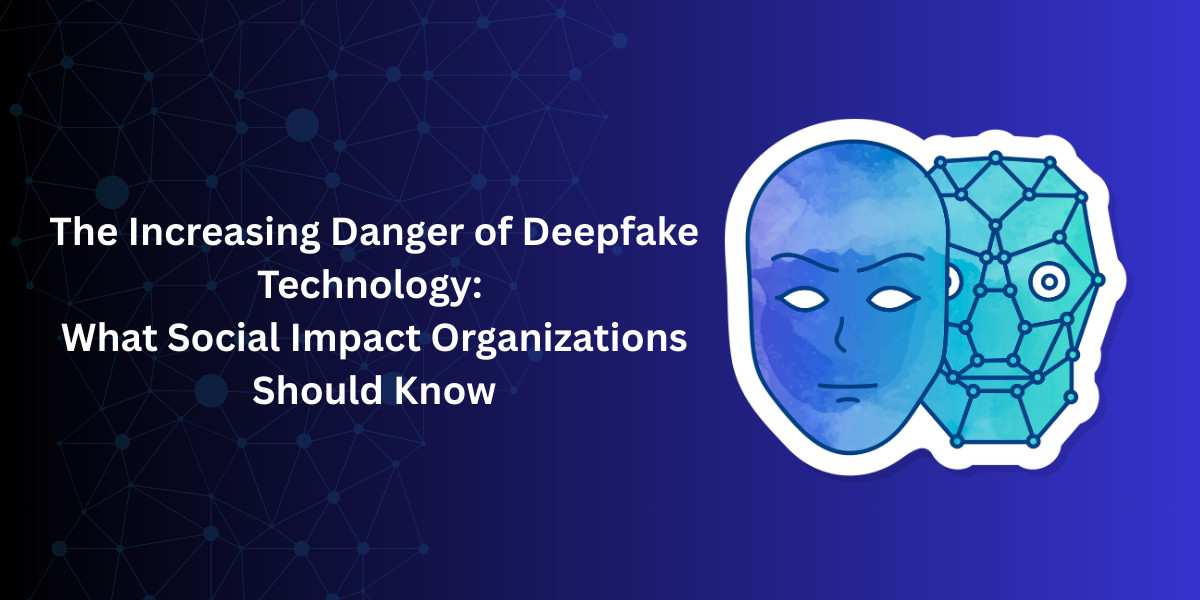You’ve probably seen videos online that made you say, “Wait, is that them?” A familiar voice, a familiar face, a message that seems to be delivered by someone you trust. But what if I told you that all of that you just saw and heard wasn’t real? Imagine I told you that a person, somewhere, utilized technology to bring it all together—with nothing but a computer screen and a bit of AI magic.
Now, don’t panic. I know this sounds like a science fiction movie. But here’s the thing: this technology, called deepfake, is no longer science fiction. It’s real, and it’s being used today. And here’s the thing—deepfake technology isn’t just a problem for politicians or celebrities. It’s a problem that could directly affect your organization, your donors, and your reputation.
Picture this: a deepfake video of your CEO saying something inflammatory or a fake fundraising message that looks like it came from your organization. Creepy, right?
And here’s the worst part: these deepfakes look and sound so real that they can crush your donors’ trust in seconds.
So, how exactly is this technology endangering your organization? Allow me to walk you through exactly why deepfakes are such a big deal for social impact organizations like yours.
What is Deepfake Technology?
Deepfake technology is synthetic media—images, videos, or audio files—produced using artificial intelligence to accurately impersonate real individuals. Such AI-created forgeries can replicate a person’s face, voice, expressions, and even the way they speak, usually rendering it impossible for the general viewer to identify as fake.
Though deepfakes were created for artistic and entertainment purposes, their abuse is fast becoming a threat to all industries. For social impact organizations, which exist and thrive on trust, integrity, and goodwill, deepfakes are a very real threat. From false donation campaigns to imitated volunteer drives, the technology is being utilized to take advantage of the values that these organizations uphold.
Knowing what deepfakes are and how they function is the best way to secure your mission against cyber deception.
Introduction: The Double-Edged Sword of AI
In an age when technology keeps redrawing the boundaries of how we communicate, campaign, and mobilize for social justice, perhaps no trend is as disquieting as the progress in deepfake technology. Deepfakes are highly realistic, AI-created audio and video fakes that can easily replicate voices, faces, and body language—making it increasingly hard to distinguish what is natural from what is created artificially.
To social impact organizations—whose existence, in fact, hangs in the balance of public trust, openness, and believability—this poses an instant and powerful threat. Unlike commercial enterprises, these organizations work in highly sensitive environments where authenticity is a non-negotiable necessity.
One deepfake, say, mimicking a respected leader making a fabricated statement, or fabricating a fund-raising campaign, can damage reputations, drain donor trust, and impair critical operations irretrievably.
While artificial intelligence has the potential to deliver in data analysis, accessibility, and education, its corruption with deepfake technology adds an extra layer of risk. For humanitarian organizations, activist groups, and nonprofits, the impact of such online deception goes beyond loss of reputation—it erodes the fabric of social good.
As the technology continues to develop, it is imperative that the social sector grasp its implications, identifies its weaknesses, and constructs prevention measures to protect the most crucial missions.
How Deepfakes Work: A Quick Primer
Ever see a video that appears completely realistic, but something just is. off? It might be a deepfake. They are created by artificial intelligence models that have been trained on real images, videos, or audio recordings to get someone to say or do something they never have.
What began as technology for entertainment and convenience is now being utilized to manipulate, lie, and fake.
Why Social Impact Organizations Are Particularly Vulnerable?
Social impact organizations rely heavily on trust and transparency, making them vulnerable to malicious actors using deepfake technology to damage their reputation and credibility. Here’s why these organizations are particularly at risk:
1. Trust Is Their Currency
- Trust is the currency of nonprofits, advocacy groups, and volunteer networks.
- A well-placed deepfake—a bogus video of a bogus CEO making an unpopular statement or a bogus volunteer coordinator making a solicitation—can burn decades of reputation capital.
2. Limited Defense Resources
- In contrast to companies, most social impact organizations do not have much sophisticated cybersecurity infrastructure or fat budgets to protect it.
- They are low-hanging fruit for cyber criminals and operators of disinformation.
3. High-Profile, High-Impact Targets
- NGO leaders, human rights activists, and social influencers are sure to be noticed immediately.
- That puts them in the sights of identity theft, impersonation, and politically motivated deepfakes.
4. Manipulating the Community Spirit
- As AI advances, we’re seeing a sharp rise in fake donation appeals, counterfeit recruitment messages, and fraudulent event invites—all crafted with deepfake precision.
- These don’t just hurt victims financially. They erode public faith in the organizations they once believed in.
Real-World Threats: The Deepfake Impact in Action
Deepfake technology is not just a theoretical threat—it’s already having a significant impact on various sectors, including social impact organizations. Here are some real-world examples where people have used deepfakes to manipulate, deceive, and disrupt
1. Financial Fraud through Executive Impersonation
- In one prominent case, hackers used deepfake video calls to impersonate a CFO and trick employees into signing off on $25 million wire transfers.
- Similarly, an imposter posing as an NGO leader used a deepfake to make a fake fundraising appeal.
- Voices of replicated execs signing off on cash.
2. Donor & Volunteer Deceptions
- Deepfake videos created by AI have impersonated celebrities and philanthropists, making it appear as though they are endorsing fictitious charities.
- Others have impersonated leading NGO recruiters with fake task allocations.
- Donors unwittingly give money to non-existent charities.
- Volunteers report for non-existent activities.
3. Targeted Disinformation Campaigns
- Deepfakes spread disinformation by creating fake speeches or videos of NGO leaders making discriminatory remarks or engaging in politically divisive actions.
- Illustration: In 2024, a deepfake audio of one of the politicians of the UK insulting his own party’s voters sparked outrage.
- Cybercriminals are using the same techniques to target leaders of civil society in India, Taiwan, and Brazil. These attacks can damage their credibility and disrupt their work, making it harder to maintain public trust and transparency..
4. Disruption of Operations using Identity Theft
- Cyber criminals have used voice-cloning to bypass security measures and gain unauthorized access to confidential data.
- Example: Re-tool employee’s voice cloned to steal client credentials.
- AI-generated “doctors” send fake advisories to health NGOs, causing confusion and harm.
5. Political Manipulation and Election Interference
- NGOs involved in election observation, civic education, or political impartiality are most at risk.
- Example: Deepfake robocalls with President Biden impersonation discouraged votes in New Hampshire.
- Misinformation endorsements have been spread during elections in over 30 countries.
The Fallout of a Deepfake Attack
- Financial Losses: Imposter donations, fraud transactions, crisis management costs.
- Reputation Harm: Public confidence is fragile; one false word can destroy decades of excellence.
- Operational Backsets: Internal personnel taken away from outreach work to deal with damage control.
- Legal and Regulatory Stress: Governments can enforce more stringent reporting, compliance, or funding limitations.
The NGO Tech Role: Building Trust with Software
While we can’t turn the clock back on AI developments, we can flex our tools and work practices to keep up. Tools like BlueTerra Volunteer Management Software help NGOs manage fundraising, donor details, volunteer scheduling, and communications in safe channels.
- Automated event invitation filtering and recruitment campaigns.
- Secure payments systems to banish fraud.
- Central dashboards to identify inconsistencies in communication.
- Training modules to teach staff and volunteers how to detect deepfake red flags.
Spending money on these platforms invests in the future, protects information, but also empowers organizations to create a strong, credible community with the ability to counteract AI-generated misinformation.
Looking Ahead: Building Resilience in the Age of AI
Deepfake technology is not disappearing—and it’s evolving rapidly. Social impact organizations can no longer rely on reputation and goodwill. They need active defenses, community verification processes, and digital literacy across the board.
“If your mission is built on truth, you must build your shield with vigilance.”
Defend your mission. Challenge what you see. Strengthen what you believe.





 April 09, 2025
April 09, 2025
